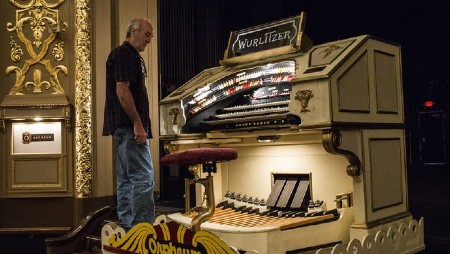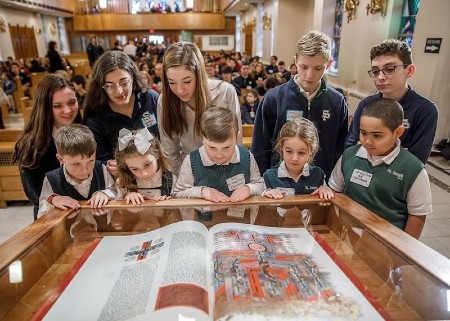For Such A Time As This: Culture Is No Luxury
By Neil Earle
 Richard Reinach, building manager at the Orpheum Theatre, raises the Wurlitzer Organ while showing off the 90-year-old instrument. $500,000 was raised to restore the organ, which made its triumphant return this month. Brad Vest/The Commercial Appeal
Richard Reinach, building manager at the Orpheum Theatre, raises the Wurlitzer Organ while showing off the 90-year-old instrument. $500,000 was raised to restore the organ, which made its triumphant return this month. Brad Vest/The Commercial AppealA friend of mine – energetic proprietor of a family business – used to joke “Every time I hear the word culture I reach for my wallet.”
Many share that sentiment. However, there comes a time when “culture,” broadly defined, has a way of cutting through the stifling fog of negativism sometimes so pervasive and giving us a taste of the timeless, the enduring. Memphis, Tennessee – a name with which to reckon in America’s rich musical culture – has recently shown the importance of reaching higher than bare survival amidst all the hubbub over restaurant closings, wearing masks and the mundane act of standing 6 feet apart from each other.
It is the task of our cultural institutions to stand above the passing parade and proclaim facing the troublesome present without surrendering some of the higher virtues we piously celebrate in normal times and sometimes when we are a bit unsure of our stand, like a man whistling through the graveyard, half fearful that my entrepreneur friend mentioned above could be right.
Two displays from the Memphis high culture reminds us that institutions we often grudgingly support in more normal times can have surprising relevance in the face of a deadly plague. The Greeks wrote some of their best plays while Spartan armies were besieging Athens and the plague raged inside. Here’s a lesson for all of us: Higher values are not suspended in times of danger, indeed they become more necessary.
“Answering the Call”
The Orpheum team hosted an event on November 19 in conjunction with their 92nd birthday. It was timed to celebrate the return of the Mighty Wurlitzer pipe organ back to its home after repairs being made in Chicago. The event was a free limited capacity concert where social distancing and mask mandates were upheld and the careful organizers promised a one-hour engagement and kept to their word.
Orpheum president and CEO Brett Batterson opened and closed the event wherein he introduced local historian and organist Vincent Astor and house organist Tony Thomas. I estimated attendance at about 300 in the Orpheum’s lower seating area, a receptive audience indeed. Perhaps the highlight came when Astor guided the shining newly-repaired Wurlitzer in a salute to “Showboat,” the 1927-1928 musical much in vogue when the Orpheum was being finished. Hearing “Old Man River” played with such feeling and elegance within sight of the mighty river itself was a fitting moment. Celebrating an American classic in a local concert hall while the bittersweet memories conveyed by the piece seemed so fitting for this time and place. In our mind’s ear we could hear Paul Robeson intoning his note of hope and resilience: “Show me that stream called the River Jordan/That’s the old stream that I long to cross.”
“Back in 2017 Memphians answered the call to restore our crown jewel,” said Batterson. It cost a cool $500,000. “We can’t wait for Memphis to hear and experience what their generosity has provided,” added Batterson. And enjoy it we all did.
 Facebook/The Saint John’s Bible
Facebook/The Saint John’s BibleIluminating the Text
Meanwhile, another Memphis institution, the Dixon Gallery & Gardens, was sponsoring an ongoing exhibit “Illuminating the Word: The Saint John’s Bible,” from October 11 to January 10. The Dixon presented 68 original pages from all seven volumes of a major new landmark project for the bestselling book in the world. The Saint John’s Bible is a product of Saint John’s Abbey and University in Collegeville, Minnesota. There the first handwritten illuminated Bible was produced in some 500 years.
Here is a decades-long project only completed in 2011 that hearkened back to the manuscript productions of the Middle Ages. At a scriptorium in Wales, 23 professional scribes and artists produced 1127 pages of text and illumination centering on handwritten calfskin with quills fashioned from turkey, swan and goose feathers and ancient inks hand-made from such ingredients as lapis lazuli and egg yolk! This Bible contains more than 160 major artworks illustrating the age-old text from Genesis to Revelation.
Here is a fitting tribute to the other side of Memphis’s premier contributions in rock, blues and country music: the religious element in this city of churches. The Saint John Bible is unique in that it combines centuries-old techniques with the latest application of computer technology and electronic techniques.
Of course, the Dixon itself, with its elegant gardens and buildings, conveys Memphis’ not-insignificant place in the history of art and culture. Jimmy Ogle tells us (that means it must be true) that there are more songs about Memphis than any other city – by far!
It was Winston Churchill who said that we shape our buildings and then they begin to shape us. The Orpheum and the Dixon are two Memphis landmarks that seemed determined not to let us down during a time of uncertainty and fear. These recent activities recall the importance of the long view, the glimpse of blue above the stormy clouds of plague and division. The world of which Memphis was a part had much to pass through in 1928 until now and yet here we are, a bit battered and worse for wear but still taking the time to demonstrate, to rephrase the poet, that “in the stress of normal lives/something noble yet survives.”
(Three-year Arlington resident Neil Earle teaches history online for Grace Community Seminary.)